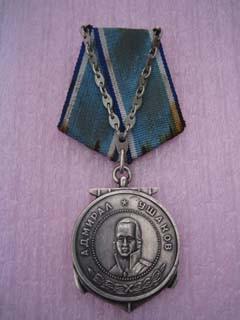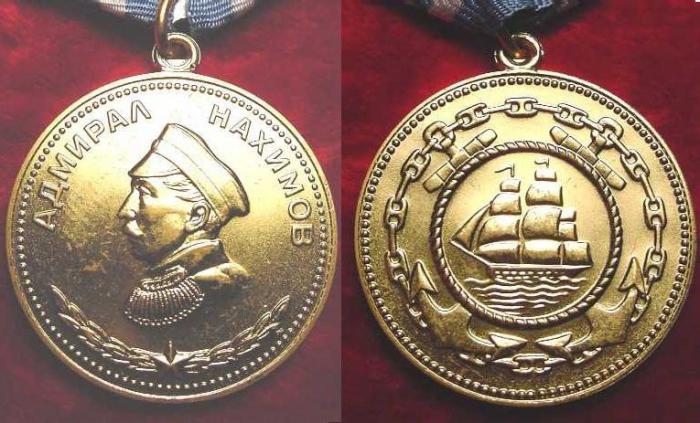
As Tsar Alexander the Third once said,Russia has only two ally: the army and the navy. Indeed, ever since Peter the Great turned our country into a great naval power, military sailors, midshipmen, admirals and captains of all ranks played a huge role in its history. In order to appreciate their merits during the Second World War, special awards were established: the Nakhimov medal and the Ushakov Medal. Today they are kept in many Russian families and in private collections of Falerists around the world.

Before considering medals Ushakov, it is worthto tell briefly about the person, in honor of which they are established, especially since this is one of the most extraordinary personalities among Russian commanders and naval commanders.
Fedor Ushakov began his career with participation in theThe Russian-Turkish war, which led to the independence of the Crimea from Turkey and the conquest of the fortresses of Azov and Kerch by Russia. They won a lot of sea battles, in which he showed himself as an excellent strategist. In addition, Ushakov left a good memory of the Greek and Bulgarian peoples and acted as a skilled diplomat in the creation of an independent republic on the Greek islands, as well as with the liberation of Italy.
After retiring, he took up charity.In particular, at his own expense Ushakov built a hospital for the veterans of the Patriotic War of 1812 and in every possible way supported the Sanaxar monastery, where he even had his cell in which he lived during his posts. Such piety allowed the Russian Orthodox Church to rank it among the saints along with such righteous warriors as Alexander Nevsky and Dmitry Donskoy.
The decree on the establishment of this award was issued on March 31944 year. It was intended for awarding sailors and soldiers, sergeants and foremen, as well as midshipmen and ensigns of the Navy and naval units of the border troops for personal courage and bravery that were shown during the defense of the Fatherland on the sea both in the period of military operations and in peacetime.
Medal Ushakov (USSR) is made of silver in the formcircle, having a diameter of 3.6 cm, placed on the anchor. On her obverse, surrounded by a convex rim, there is a breast relief depiction of Admiral FF Ushakov. Above it there is a convex inscription "Admiral Ushakov" on the circumference, and under the portrait there are 2 laurel branches connected by a crossed ribbon. As for the reverse, the medal number is simply knocked out. The award with the help of a ring and a small eye is connected with a 5-corner shoe, which is covered with a silk ribbon of blue color. Its width is 2.4 cm, and along the edges it is marked with white and blue stripes.
The Ushakov Medal has a cardinal difference fromother Russian awards. The fact is that its shoe is decorated with an anchor chain that is fastened over the ribbon and connects the upper shoe corners with the eyelet. This design is not found in any other Soviet medal.

The medal was re-established by presidential decree.RF in March 1994. Externally, it is an exact replica of the Ushakov Medal of the Great Patriotic War, and today it is awarded to military personnel of the Navy and the marine security agencies of the Frontier Service of the FSB of the Russian Federation. It should be worn on the left side of the chest, and if the recipient has other RF medals, it is placed after the Suvorov medal.
This award was established simultaneously with the medalUshakov and also intended for non-official personnel of the VMG and the maritime units of the border troops, who showed courage and bravery in the performance of military duty.

Made of bronze in the form of a circle with a diameter of 3.6 mm.On the obverse of the Nakhimov medal there is a convex image of the admiral in profile, below which are crossed laurel branches connected by a five-pointed star. The inscription “ADMIRAL NAHIMOV” is printed along the convex side, duplicated by relief points at the top of the medal. This award has a reverse design, which is not typical for medals of the period of the Great Patriotic War. In particular, it depicts a circle, and inside it - a sailing vessel sailing on the waves, behind which two sea anchors are crossed. At some distance from the rim in a circle, a relief in the form of a ship chain is applied.
The first award of the Nakhimov medal took place onThe Northern Fleet is already April 10, 1944. It was received by Sergeant M. A. Kolosov, as well as by sailors E. V Tolstov and F. G. Moshkov. In total, by 1981 in the USSR, 13,000 people were awarded the Nakhimov medal.

In 2012, in honor of the 70th anniversary of the beginning of the Arcticconvoys by the Russian government decided to celebrate the merits of their participants. As a reward, the Ushakov Medal was chosen. The list of awardees was sent to the USA and the UK, where it was supposed to organize solemn ceremonies with the participation of Russian diplomats. In the same year, April 27, in the United States, 56 veteran sailors were awarded Ushakov's medals. The situation was more difficult with the participants of the Arctic convoys from Great Britain. The fact is that according to the laws of this country, citizens of Her Majesty are forbidden to accept foreign awards, therefore the request of the Russian side was rejected. In this case, the British established their own award for their veterans, calling it the “Arctic Star”. However, after its presentation, the British government changed its mind, and the Russian medals were nevertheless delivered to London, as well as to Edinburgh. There were solemn ceremonies for awarding brave sailors, who 70 years ago delivered important military and food supplies to Murmansk and Arkhangelsk.

Faleristics is a popular hobby aroundworld, so Russian awards are often in different parts of the world. Among them, not the last place is occupied by the medal of Admiral Ushakov, which is distinguished by an unusual design, designed by the architect MA Shepelevsky. The price of this award ranges from 120,000 to 130,000 rubles. Approximately the same is the Nakhimov medal. As for their copies, their price is about 1000 rubles.
Now you know what the Ushakov medals look like and who the person in whose honor they were founded was.


























